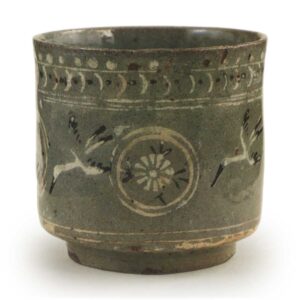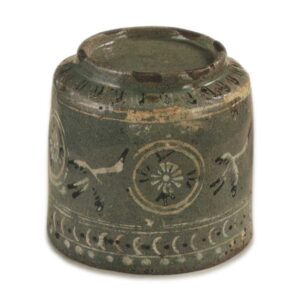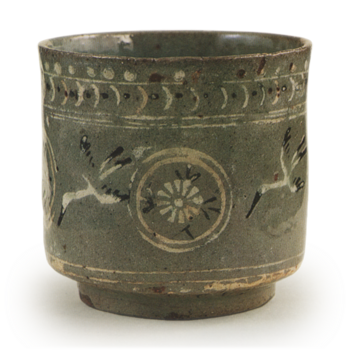

Name: Omotajikara
Daimyo-butsu
Height: 7.9-8.0cm
Diameter: 8.2-8.5cm
Base diameter: 5.9-6.0cm
Height: 0.6cm
There are two main types of inlaid celadon known as “cloud crane” and “kyogen hakama”. The first type is thought to have been produced at the end of the Goryeo period, and is considered to be the genuine article. The second type is from a later period, probably from the Busan kiln, and is more obviously designed, with a less refined shape and color than the first type. Although almost all tea bowls in the tea world that are generally referred to as Goryeo tea bowls are actually made during the Yi Dynasty, the inlaid celadon of the former is clearly a Goryeo tea bowl, as the name suggests. In the height of the Goryeo period, inlaid celadon was a technique that was often used to create works of outstanding skill and refinement, but by the end of the period it had begun to decline, and the pieces that were produced became increasingly crude. By the time of the Muromachi period, when the wabi-cha tea ceremony was becoming popular, the less refined inlaid celadon of the late Goryeo period was being selected for its suitability to the wabi aesthetic. This Hitta-tsubo is one such famous bowl, and it was named Hitta-tsubo, also known as Daimonjiya-tsubo, after it was owned by Hitta Sokan of Daimonjiya in Kyoto, and it was praised alongside other famous bowls of the same type, such as the Hikigashira-tsubo. It is a slightly smaller cylindrical shape, and compared to other similar tea bowls, it is simple and linear, with a crisp, well-defined shape and well-balanced dimensions. The body of the Soko is thin overall, and because it is glazed all over, the texture of the clay is not visible, but through the glaze, it has a calm blue-grey color, and it can be seen that the clay contains countless minute black spots.
In order to add the elephant-patterned design, it is necessary to press the pattern into the soft clay while it is still soft, but in this case, the pattern is pressed into the thin clay, so that part of the clay has been slightly depressed, and therefore the sides of the bowl have subtle bumps and hollows all over the inside and outside. The rim is also not perfectly straight. However, this type of shape, which tends to be rather stiff, is made softer and warmer by this.
The pattern consists of four each of the flying crane pattern and the double circle with chrysanthemum pattern, which are arranged alternately on the body. Needless to say, the crane is the main theme of the Unkaku, and the circle pattern is the pattern of the Kyogen hakama, so this tea bowl is both a Unkaku and a Kyogen hakama. The upper part of the bowl is decorated with a banded pattern of crescent shapes and small dots, the lower part has a double line pattern, and the foot ring has a simplified lotus petal pattern. The glaze is thin and transparent, giving the bowl a beautiful sheen, and the black inlay pattern against the white background really stands out against the subdued body color, giving the bowl a fresh and bright feel. These patterns are not as elaborate as those of the high-quality Goryeo celadon of the period. However, the roughness and roughness of the patterns are interesting, and the clumsy appearance of the flying crane is particularly in line with the tastes of tea masters.
Furthermore, it is customary for tea bowls of this type to be slightly deep and cylindrical, but it is said that in Korea, this bowl was actually used as a medicine bowl for drinking ninjin-tou. It is thought that in the past, this bowl was also used as a medicine bowl in Japan, and that tea masters later converted it to a tea bowl.
It was originally owned by Sōkan Hotta of the Daimonjiya tea house in Kyoto. Sōkan was a disciple of Sōgo Matsumoto of the Shukōmon tea house. In the Eiroku era, Oda Nobunaga confiscated his treasured Hatsu-hana tea caddy, but it is said that he kept this tea bowl hidden. During the time of Sōkan’s son Sōmi, it was praised alongside the wooden tea caddy owned by Rikyū. After that, it was in the possession of the Osaka Tanimatsuya Sōchō family for a while, and then it was passed on to the Wakasu Sakai family in 1849, and is now in the possession of a certain family in Kyoto.
There are no particularly noteworthy accessories, but it comes with three accompanying notes.



